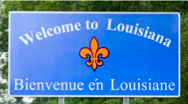The 2000 U.S. Census says there are approximately 190,000 people in Louisiana speaking French at home. At that's just one of several Francophone communities in the Americas.
French professor Brian Barnett recently conducted an informal experiment with his second-year students. Their assignment: “Write down the first 10 things that come to mind when you think about the word France.”
Students dutifully complied: "Eiffel Tower, baguettes, cheese, perfume. . . ." When Barnett collected the answers he noticed a gaping omission. "They mostly listed items associated with France--not with the broader Francophone-speaking world," he said. "It's a common American reaction to think only of France."

French is in fact a significant global language spoken by cultures on every continent—including large communities in the U.S. For instance, according to the 2000 U.S. Census, approximately 190,000 people in Louisiana reported speaking French at home.
For more than 200 years leading up to the mid-1900s, French was the international language of diplomacy, consistent with France’s prominent position as a global presence occupying parts of Africa, the South Pacific and the Americas. As English has replaced French as the dominant international language, interest in French as a second language has swiftly declined, especially in the U.S. where Spanish has become the most studied foreign language in high schools and colleges.
Therefore Barnett, a new addition to the Department of Romance Languages, is on a mission to remind students of the relevance and cultural contributions of French to the Americas. His research and teaching interests are focused especially on the Francophone communities in Louisiana, the Caribbean, Quebec and Maritime Canada (Acadia).
In addition to Louisiana, there are other large French-speaking populations elsewhere in the U.S., particularly the Franco-Americans in New England and Florida (the latter with a Haitian influence), Barnett says.
Though each Francophone community on the American continent shares a common language, the unique cultures of each location have created vibrant dialects to study and celebrate. To Barnett, such communities are an opportunity to expose students to a more complete picture of where French was (and is currently) spoken closer to home, as well as introduce students to linguistic variation.
“There are a variety of French dialects, just as there are of English or of any other language,” said Barnett. “One particular variety is not superior to another— we’re just most familiar with the dialect spoken in Europe. Recognizing that each Francophone region carries with it cultural and historical significance is part of becoming truly bilingual in French.”
—Patricia Hickson





 Watch
Watch  Watch excerpts from the opera, coming soon to Eugene.
Watch excerpts from the opera, coming soon to Eugene. 

 Three’s a charm for a living memorial.
Three’s a charm for a living memorial.